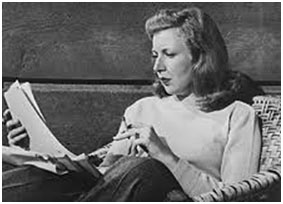

Martha Ellis Gellhorn (November 8, 1908 – February 15, 1998) was an American novelist, travel writer, and journalist, considered by the London Daily Telegraph, among others, to be one of the greatest war correspondents of the 20th century. She reported on virtually every major world conflict that took place during her 60-year career. Gellhorn was also the third wife of American novelist Ernest Hemingway, from 1940 to 1945. At the age of 89, ill and almost completely blind, she committed suicide. The Martha Gellhorn Prize for Journalism is named after her.
Gellhorn first met Hemingway during a 1936 Christmas family trip to Key West. They agreed to travel in Spain together to cover the Spanish Civil War, where Gellhorn was hired to report for Collier's Weekly. The pair celebrated Christmas of 1937 together in Barcelona. Later, from Germany, she reported on the rise of Adolf Hitler and in 1938 was in Czechoslovakia. After the outbreak of World War II, she described these events in the novel A Stricken Field (1940). She later reported the war from Finland, Hong Kong, Burma, Singapore, and Britain. Lacking official press credentials to witness the Normandy landings, she impersonated a stretcher bearer and later recalled, "I followed the war wherever I could reach it." She was among the first journalists to report from Dachau concentration camp after it was liberated.
She and Hemingway lived together off and on for four years, before marrying in December 1940 (Hemingway also lived with his second wife, Pauline Pfeiffer, until 1939). Increasingly resentful of Gellhorn's long absences during her reporting assignments, Hemingway wrote her when she left their FincaVigía estate near Havana in 1943, to cover the Italian Front: "Are you a war correspondent, or wife in my bed?" Hemingway himself, however, would later go to the front just before the Normandy landings, and Gellhorn would soon follow, with Hemingway trying to block her travel. When she arrived by means of a dangerous ocean voyage in war-torn London, she told him she had had enough. After four contentious years of marriage, they divorced in 1945.
The 2012 film Hemingway &Gellhorn is based on these years. The 2011 documentary film No Job for a Woman: The Women Who Fought to Report WWII features Martha Gellhorn and how she changed war reporting.
After the war, Gellhorn worked for the Atlantic Monthly, covering the Vietnam War, the Six-Day War in the Middle East, and the civil wars in Central America. At age 81 she even travelled impromptu to Panama where she wrote on the U.S. invasion. Only when the Bosnian War broke out in the 1990s did she concede she was too old to go, saying, "You need to be nimble."
Gellhorn published numerous books, including a collection of articles on war, The Face of War (1959); a novel about McCarthyism, The Lowest Trees Have Tops (1967); an account of her travels (including one trip with Hemingway), Travels With Myself and Another (1978); and a collection of her peacetime journalism, The View From the Ground (1988).
Peripatetic by nature, Gellhorn reckoned that in a 40-year span of her life, she had created homes in 19 different locales.



















